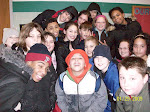
After reading Will Richardson's Blogs, Wikis, and Podcasts, several implementations of the possible applications of weblogs in my classroom were exposed. First, the use of weblogs to document assignments and classroom activities is an excellent resource for teachers, students, and parents. Posting assignments on a weblog assists families in ensuring their child is completing assignments. This would also allow teachers to post exemplars and explicit directions so that if students or parents have questions they can reference the weblog for further instruction. Using a weblog to post assignments is also economically friendly due to lack of numerous handouts and assignment notebooks for students. Using a weblog to post assignments and projects will support students in knowing their responsibilities for homework and eliminate student’s misunderstandings with knowing what and when assignments are due.
Another use for weblogs that can be implemented in my class would be developing an ongoing posting of student work. Creating a virtual display of student work would allow students to share writing and ideas about different content area. Several of my students aren’t as vocal and comfortable sharing personal work in the classroom. Giving students the opportunity to post their work on a weblog would allow them to share work and comfortably critique each other. Students can learn a great deal from consuming each others work, critiquing their work, and producing their own work. Using a weblog for students to interact with each other would foster this concept and promote self-confidence in student work.
Last, I feel that communication with parents and students are extremely important to develop a safe and welcome learning environment. My school is currently promoting a Book Club implementation for our reading instruction. I thinking developing a blog for the different books being read in our class would be an excellent way for students to share their thoughts, ideas, questions, and opinions about the book. Part of the NYS Fifth grade curriculum includes students understanding different elements of author’s craft. Contacting the author of the book to participate and assist in answering questions the students may have would be a great experience for all parties involved. In addition parents would be able to view what their child is reading about and interested in. The blog could assist parents in understanding their child’s point of view or underlying questions in their child’s life. Parents could be encouraged to read the book along with their child and communicate through the postings. This resource would be very valuable for parents and students to use as a communication device prior to entering the middle school years. Using a weblog for communication about texts being read in class is an excellent tool to foster literacy inside and outside of the classroom learning environment.





